Our destination this week is Bouvet Island, which is an Antarctic volcanic island located in the south Atlantic ocean. It is more than 1,500 miles from South Africa, its nearest populated neighbor, and over 1,000 miles from Queen Maud Land, Antarctica, where there is a Norwegian research station. Bouvet Island holds the impressive distinction of being the "Most Remote Island on Earth," which means, of course, that it has no population to speak of--no researchers, and only the occasional bold adventurer. And penguins.
 |
| Bouvet Island, a tiny spec thousands of miles from anywhere. |
Bouvet Island is a dependent territory of Norway, which I find a little funny because as far as I can tell it's a pretty useless chunk of ice and rock that may hold some interest for science, but is mostly useful in its ability to give well-financed explorers a chance to, well, check "The Most Remote Island on Earth" off of their bucket list. This means that despite its remoteness, Bouvet Island is a destination, and destinations always have purveyors willing to sell someone the experience of traveling to that destination, and those travelers of course need to be fed.
 |
| Bouvet Island, the most remote island in the world. |
So after only a little bit of research on the subject, I hit on a ship called the "Hanse Explorer," which among other things takes small groups of people to remote destinations such as Antarctica and, yes, Bouvet Island. The Hanse Explorer is an "icebreaker" ship that was "purposely built for Arctic/Antarctic Exploration," but this ain't no barebones research vessel. This is a luxury yacht that just happens to be outfitted for very cold, very remote destinations.
And so began my fruitless email campaign. I emailed the charter company, several people who have posted online accounts of their Hanse Explorer journey to Bouvet Island, and I spent/wasted quite a lot of time waiting for people to get back to me. Alas, only one person did, and he was kind enough to forward my message along to the chef onboard the Hanse Explorer, which briefly made me think I'd hit the jackpot. Sadly, though, I am but a lowly blogger, and coughing up $115,000 a week for a trip to Bouvet Island is neither on my to-do list nor on my within-the-realm-of-any-kind-of-possibility list, which I suppose ranks me fairly low on the scale of people worth getting back to. So I never heard from the chef, or from anyone else involved with the Hanse Explorer's charter business.
I did, however, during the course of my deep scrounge of online resources, find several references to the sushi served on board the Hanse Explorer. I was also lucky enough to find a single recipe for one of those sushi rolls, transcribed from a German-language article about the galley on board the Hanse Explorer. The other two recipes I decided on were a basic tuna nigiri, because what sushi spread doesn't have one of those, and a spicy tuna roll recipe that came from a chef who works on board a different yacht. A stretch, I know, but hey, these non-country entries are usually mostly fantasy anyway.
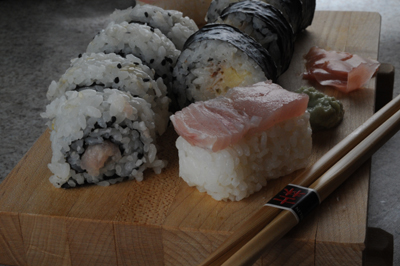 |
| My fantasy menu from Bouvet Island. |
Fortunately I've made sushi a few times before, so the prospect of doing so again wasn't that daunting. I already had a sushi mat, serving boards, a rice paddle and a nigiri mold. The only thing I didn't have were the chopsticks, because Dylan recently turned all of my nice chopsticks into Harry Potter wands. So I had to pick up a few of those but after that I was mostly ready to go.
Before you can make sushi, you have to make sushi rice. This is Alton Brown's sushi rice recipe, halved. It makes exactly two sushi rolls and four pieces of nigiri (enough for two pretty decent sized meals); if you're going to feed a bigger crowd you'd need to double it, but since sushi isn't a terribly kid-friendly dish I figured the halved version would be more useful.
Sushi Rice
- 1 cup sushi or short grain rice
- 1 cup water
- 1 tbsp rice vinegar
- 1 tbsp sugar
- 1 1/2 tsp kosher salt
Next, the semi-official Hanse Explorer sushi roll, transcribed from a German article, which I've decided to call a Polar Roll. I've had to guess at the measurements but I figured on them being pretty similar to a California roll.
Polar Roll
- 2 tbsp fresh or canned crabmeat
- 1 tbsp mayonnaise
- 2 sheets nori (dry seaweed)
- 1/4 cucumber, cut into thin spears
- 1/4 apple, peeled cut into thin spears
- 1 cup prepared sushi rice
Next is a basic spicy tuna roll recipe, which I have taken the great stretch of including in the Bouvet Island entry based solely on the fact that it comes from a chef who works onboard a yacht, although not the Hanse Explorer or any other Bouvet Island-destined ship.
Spicy Tuna Roll
(This recipe comes from Victoria Allman)
- 1 tsp mayonnaise
- 1/8 tsp wasabi
- 2/3 lb fresh tuna, diced fine
- 2 sheets toasted nori
- 4 tsp white sesame seeds
- 2 tsp black sesame seeds
- 1 cup prepared sushi rice
And finally, almost every sushi spread I've ever seen includes a basic tuna nigiri, and here's the recipe:
Tuna Nigiri
- 4 oz ahi tuna (I used albacore, because the co-op didn't have ahi)
- 1/2 tsp prepared wasabi
- 1 cup prepared sushi rice
A couple of notes: if you're going to make all three recipes using the sushi rice measurements above, you will need to halve the roll recipes, which will give you one of each roll. Otherwise the rice amount will be just enough for one of the roll recipes and the nigiri.
You do need to make the rice ahead of time so it will have time to come to room temperature (important!), so let's start there.
First a quick note: don't try to substitute long grain rice in this recipe; you need to use sushi rice or your sushi won't hold together.
 |
| This is sushi rice. See how short the grains are? |
First rinse the rice in a fine mesh strainer until the water runs clear.
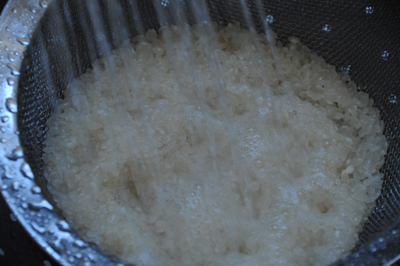 |
| Stop rinsing when the water is no longer cloudy. |
Put the rice and the water in a small saucepan and turn on the heat. Bring to a boil, then cover and reduce heat to low. Simmer for 15 minutes, then remove from the heat and, without taking the lid off, let stand for 10 minutes.
Now mix the vinegar with the sugar and salt. You can use a small saucepan to heat the mixture, or you can just pop it into the microwave for 20 or 25 seconds.
Put the rice in a bowl and pour the vinegar mixture over it. Mix thoroughly. Your goal is to make sure that the vinegar/sugar/salt mixture covers each grain of rice.
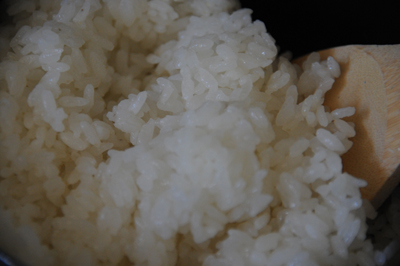 |
| Coat the rice with the vinegar mixture. |
Now let the rice stand until it reaches room temperature.
When the rice is ready, start on the spicy tuna rolls. If you've never made sushi before relax, it's actually not difficult.
First mix the tuna with the wasabi and mayo. Set aside.
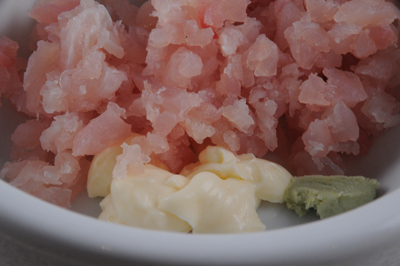 |
| This spicy tuna roll is made with albacore, mayo and wasabi. |
Now cover your sushi mat with plastic wrap to prevent sticking, and lay it on your work surface so the slats are horizontal. Get a little bowl of cold water and place it next to the mat. Now take one sheet of nori and place it shiny-side down on the mat.
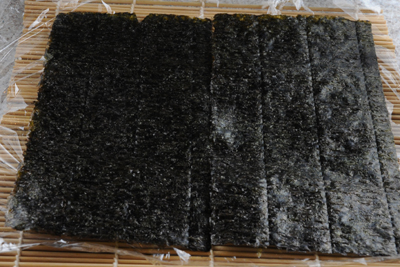 |
| For reasons unknown, my stupidly expensive organic nori came in half sheets, so I had to lay two down side by side. |
Grab a handful of rice and spread it over the nori sheet, using the water in the bowl to keep your fingers wet, which will make it a lot easier to get the rice into the right place. Yes, the rice is supposed to be that sticky. If it's not all over your hands and refusing to come off, then you haven't made it right.
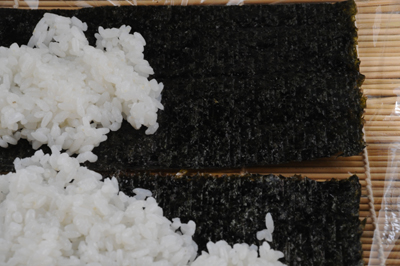 |
| Put the rice on the nori and use your fingers to spread it around. |
Try to get the rice as close to the edges of the nori as you can, while leaving a half-inch or so strip at the top. Sprinkle the white and black sesame seeds evenly over the rice.
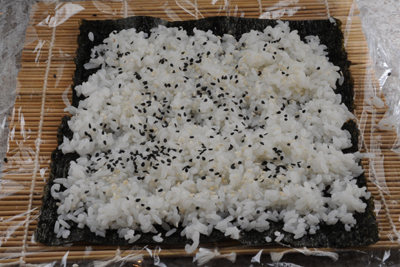 |
| When the rice covers the nori, sprinkle on the sesame seeds. I left a little too much space at the edges so I had to trim my rolls when I was finished. |
Now carefully lift the nori sheet and turn it over, so the rice is facing down and the nori is the top layer.
 |
| Flip the sheet over (don't worry, the rice sticks very well). See that seam? If you are using a full sheet of nori you won't have to worry about that. |
Spread a thin line of the tuna mixture across the length of the nori, a couple of inches from the bottom of the sheet.
 |
| Now add a strip of tuna mixture. |
With your sushi mat, roll the nori sheet away from you, pressing down with the mat to make a tight roll. You'll need to keep repositioning the mat and the plastic wrap so it doesn't get rolled into the sushi.
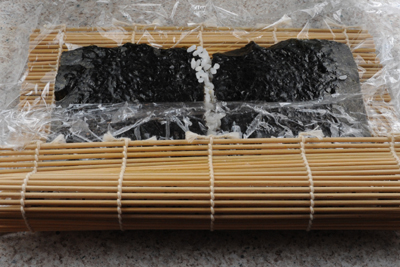 |
| Roll away from you, pressing down tightly with the mat. |
Keep rolling, using the mat to make the roll tight. When you get to the end, remove the mat.
Cut the roll in two, then cut each of the halves in two. Now cut each quarter in two. You should have eight evenly sized pieces.
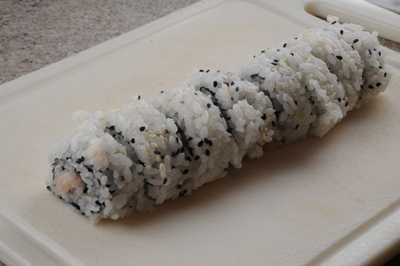 |
| Cut the roll into eight pieces. |
The polar rolls are made in almost exactly the same way:
Mix the crab with the mayo. Set aside. Lay down the nori on your sushi mat and cover it with a layer of rice. This time you don't need to flip the nori over. Just lay the crab mixture down in a thin strip over the rice, a couple of inches from the bottom of the nori sheet. Now put the cucumber and apple strips over the crab, horizontally.
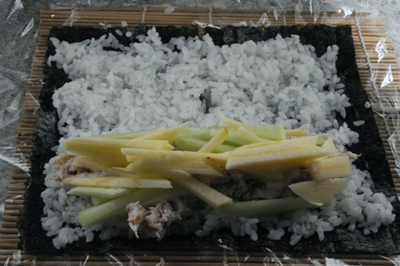 |
| Lay down the crab mixture, the apple and cucumber. |
Roll the sushi up in the same manner as you did the spicy tuna rolls, and cut the roll into eight pieces.
Finally, the nigiri, which is pretty simple if you have a mold.
Press the rice down into the sushi mold and transfer to your work surface. If you don't have a mold, you can just shape the rice using your hands.
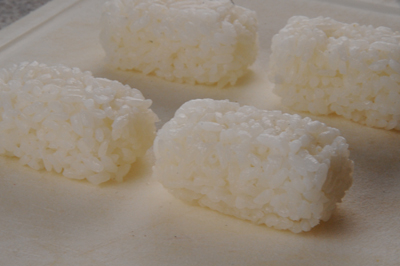 |
| My mold makes pretty thick nigiri. |
Put a dab of wasabi on top of the rice.
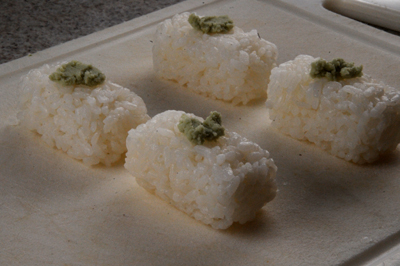 |
| Add a dab of wasabi ... |
Now lay a thin slice of the tuna over the rice. Done!
 |
| ... and cover with a slice of tuna. |
Serve your sushi with pickled ginger, wasabi and soy sauce on the side.
So obviously, I did not feed this to my children, because it's way too much money and work to waste on the unappreciative. As for my opinion, well, I love sushi, and it's pretty hard to screw up since you can't overcook it or anything. The apple was something I've never had in a sushi roll, and I thought it was a nice addition. I do like sushi that has a little bit of crunch.
As for the spicy tuna, I thought that using wasabi to make the roll spicy was a little redundant, since most people eat their sushi with wasabi anyway. When I've made spicy tuna in the past I've used Sriracha chili sauce, which is what I'll also do the next time I make spicy tuna.
Martin enjoyed his dinner too but for the most part I think we were both underwhelmed—not by the sushi itself, because as long as the fish is fresh sushi is almost always yummy—but by the non-uniqueness of it. I do wish I'd heard back from someone on the Hanse Explorer, but since these pseudo-countries are really just little bits of culinary fiction, I guess I can't complain too much.
Next week: British Indian Ocean Territory
For printable versions of this week's recipes:











Hi Becki
ReplyDeleteI've done biological research on Bouvet. Email me at greghofmeyr@gmail.co.za if you want a popular recipe from one of the trips.
Greg
Hi Greg, that would be fabulous! I'll send you an email. I really felt like I was shooting blind with this entry and would love to do it again. Thanks!
ReplyDelete